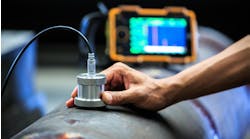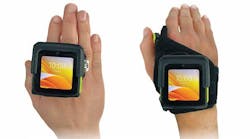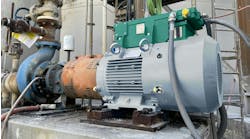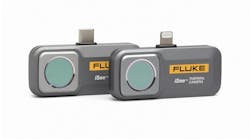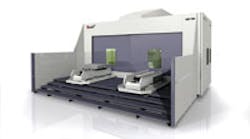The MAG HMC 1250/1600 Series is a horizontal machining center for large parts, and availalbe now with a 180,000-position A-axis tilt spindle for 5-axis machining. The new 6,000-rpm tilt spindle joins a 10,000-rpm spindle, high-speed 24,000-rpm spindle, high-torque 2,600-Nm (1,918 ft lb) spindle, and two live spindles (110 or 130 mm diameter) as headstock options.
Machining may seem to be an activity on the fringe of the forging process, but it’s a critical aspect of the job of ensuring that customers get the quality and accuracy in the components they order. Machining forgings is also an increasingly important way for forgers to add value to their products.
Machine tool builders are taking notice. At last fall’s IMTS event, numerous designers of CNC systems emphasized their products’ capability for machining the very large-dimension forgings that are needed in OEM sectors like power generation and aerospace.
For example, MAG Industrial Automation Systems presented a five-axis Giddings & Lewis machine, the modular HMC 1250/1600 Series, with a new 180,000-position A-axis tilt spindle for five-axis horizontal machining on large parts.
The HMC 1250 Series is engineered for high-precision, high-productivity machining of large aerospace, power generation, pump, valve, and off-road equipment parts. Major machine components, including the X-bed, Z-bed and column are cast in ductile iron for solidity, with 1,250 1,600 mm pallets, headstock and rotary table housings of gray cast iron. Modular design provides a range of machine travels, 60- to 120-tool magazines and two control choices, in addition to five spindle options, plus tilt capability — all enhancing the machine’s flexibility for finishing large parts. That flexibility combines with maximum 3,000-mm (118-in.) work zone swing range, 2050 mm (81 in.) work height capacity and 7,000 kg (15,400 lb) work load.
MAG’s new HMC offers 56- to 80-kW (75- to 107-hp) spindle power, 35-kN (7,870 lb) Z-axis thrust, and super-rigid, full-contouring hydrostatic rotary table. Productivity is enhanced with 40-m/min (1,575-ipm) rapid traverse/feed rate and 15-sec. tool change (for up to 35-kg tools) to maximize in-cut productivity.
A standard 360,000-position contouring table enables precision four-axis machining of a variety of part geometries. The hydrostatic table make the machine platform sturdy, while a rugged worm-gear drive with clamp securely holds axis position.
To address the ongoing need for tighter part tolerances and greater machining accuracies, the HMC Series comes standard with linear scale feedback in X, Y and Z axes, providing 8-micron (0.0003 in.) positioning accuracy and 5-micron (0.0002-in.) repeatability. Heavy-duty hardened and ground roller guide ways enable higher rapid traverse and acceleration/deceleration rates with double the load capacity and nearly 10 times the wear life of ball-type ways.
Titanium, too
Also introducing a new CNC for large parts was StarragHeckert AG, which has been manufacturing machine tools for aircraft structural parts since the 1920s, and for machining titanium components for over 30 years. The new challenge is to machine extra-long (up to 4.5 m) titanium parts.
The new “Big Titanium Profiler 5000” (BTP 5000) system weighs over 200 metric tons. The design has four axes on the tool side and one on the workpiece, forming an installation with “extraordinarily high static and dynamic rigidity of the frame structure,” according to Walter Hagspiel, machining center project manager for StarragHeckert AG. “This again is the ultimate requirement for efficient processing of materials like titanium which are difficult to cut.”
A conceptual rendering of StarragHeckert AG’s large-scale profile mill for titanium parts.
The combined weight of the the pallet and the workpiece means that latter should be moved as little as possible during processing, which is why the machine was designed for just one, short linear movement, the Z axis.
“The Z slide with pallet and workpiece (or workpieces) floats via stickslip-free roll-recirculation systems on stable double guide-ways and is moved by high-performance, ultra-dynamic servo motors via two ball screw spindles with preliminary transmissions. This duplex layout of the drives and guideways (which also applies to the X and Y axes) gives the high rigidity we need,” explains Hagspiel, “and feeds the high feed forces that are indispensable for the titanium machining into the slides symmetrically to the inertia and friction centers of the masses being moved.”
The high rigidity and the high level of absorption are maintained with the X and Y linear movements, too, and with the two rotational axes A and C on the fifth axis of the BTP 5000, which are situated on the tool side. This is ensured on the two linear axes by the conceptual design of the frame structure and its dimensioning as well as by the gantry drive and set-up of the guideways.
The swiveling head that is the core of the BTP 5000, the A (+/-100°), and C axes (continuous) over the worm drive, as well as the worm gear and the pinion in the A axis, are all made of hardened steel.
An automatic pallet-changer with two pallets is included to provide basic automation for workpiece changing.
Versatility + Flexibility
Not every forging has large-scale dimensions. An important aspect of current CNC design is the flexibility for multi-axis machining required by job shops. DMG/Mori Seiki debuted its Mori Seiki X-class last fall, a new machine series that emphasizes better cost performance by significantly reducing the number of parts. These machines are designed to reflect current machine shop needs with high speed, high rigidity, high accuracy, plus energy savings, compliance with safety standards, and design variations.
Wabtec machines up to 150 different types of parts in a week, but for high-value, large-dimension workpieces quality takes precedence over throughput.
Different models of the Mori Seiki X series have been introduced for horizontal, vertical, and mill/turn operations, with different dimensional capabilities according to customers’ needs.
Mazak is emphasizing multi-tasking capabilities with its new INTEGREX j-Series machines and the expansion of its INTEGREX i-Series machines. The j-Series and i-Series are part of Mazak’s “Five Levels of Multi-Tasking matrix,” which is meant to streamline buyers’ machine-selection process. Using this guide, the full range of Mazak’s multi-tasking machines are organized according to functionality and capabilities, and on the workpiece types and production volumes for which they are best suited. Each level in Mazak’s multi-tasking segmentation represents a progression in machine capability and complexity of application. Collectively, the five levels encompass small to large machines providing simple to complex functionality and applications ranging from prototyping to high-volume production.
Setting Priorities
Naturally, selection is meant to certify performance, whereas in operation different priorities will inevitably emerge. Wabtec Passenger Transit Div. is not a forger, but its multi-dimensional operation in Spartanburg, SC, machines forgings among the several dozen different setups it runs every week —up to 150 different products to be finished, according to Dale Simmes, manufacturing engineer.
In Spartanburg, Wabtec manufactures pneumatic, hydraulic and electro-pneumatic brake equipment, car couplers, current collectors, and other critical components for interurban passenger transit systems, as well as for railcar OEMs like Alstom, Bombardier, and Kawasaki. Wabtec also manufactures electronic and pneumatic transit door mechanisms.
Not long ago, Wabtec increased production of two-piece drawbar assemblies by 66% using its MAG Giddings & Lewis 1600 horizontal machining center (see above) for the finished parts. The machine’s 31.5-in. live-spindle reach eliminated the need for the shop to deploy a second machine and setup, and its spacious worktable allowed the engineers to add the third major component of the drawbar assembly, the yoke, on the pallet. That has freed up another machine in the process.
Increased demand drove a need for greater productivity on the drawbar machining operation. Wabtec previously machined the 181-kg (400-lb), mild steel drawbars on a single-pallet, horizontal spindle machine with limited reach, resulting in the need for another machine to cut features deep inside the parts.
“We identified setup reduction and machine speed as two areas of opportunity for improvement, and we found solutions to both with the dual-pallet HMC 1600,” according to Simmes. “We were looking for a machine with long spindle extension that would allow us to eliminate a second machine and two hours of cycle time, which had been needed to cut hard-to-reach pads on these parts.”
He added that the horizontal machine’s twin-pallet design is inherently more productive than a single-setup system.
The HMC 1600’s dual, 1,600-mm (63-in) 1250-mm (49-in) pallets, and 360,000-position contouring table allow Wabtec to machine the drawbars as a set. Its hydrostatic table provides a rigid platform, while a rugged worm-gear drive with a clamp securely holds axis position, to enable precise, four-axis machining of a variety of part geometries. Full Z-axis reach of up to 800-mm (31.5-in.) allows deep-cavity milling to high precision, using shorter more rigid tool lengths. MAG’s exclusive Z-axis thermal compensation software, standard on the live spindle, dynamically offsets spindle growth to maintain the ±0.0254-mm (±0.001-in.) tolerance required on the drawbars.
The 35-m/min (1,378-ipm) rapid traverse rate of the HMC 1600 is critical for Wabtec in decreasing cycle time. “It is remarkably fast for a large machine,” Simmes added. Heavy-duty hardened and ground roller guide ways enable high acceleration/deceleration rates and provide a wear life nearly 10 times greater than ball-type ways. A 75-second pallet-change and 15-second tool change also improve cycle time.
Wabtec uses various machines to produce the drawbars and other railway components, including thread mills, boring bars and some customized tooling. “We have two 50-tool pallets set up in a 100-tool magazine for the drawbar work, and we bought an extra 50-tool cart for some of the smaller jobs we run on the machine,” said Simmes. The HMC 1600 is available with tool cassettes capable of carrying up to 300 tools with a maximum length of 650 mm (25.6 in), and weighing up to 40 kg (88 lb). A chain magazine with a tool capacity of 50 kg (110 lb) is also available. Maximum tool diameter is 125 mm (4.9 in) in a full magazine, and 300 mm (11.8 in) in an empty-adjacent.
“Once we put the job on the MAG machining center, our production went jumped from 4.5 parts per day to 7.5 parts per day,” said Simmes. “We realized a nice bonus, too, when we were able to add the third component of the assembly onto the pallet, which freed up another machine for other work.”
| All in the programming Somers Forge, an open-die forger in Birmingham, England, supplying products to the smarine, power, and oil/gas sectors, chose a software product from NGC CAM Solutions Ltd. because it is easy to use but also reliable, and compatible with Solidworks 3D CAD software from which so many component designs are derived, and with the machine tools they operate. NCG CAM is a stand-alone high-speed machining CAM system that integrates with existing CAD and CAM systems, including CATIA’s Pro/ENGINEER as well as SolidWorks. Its features include automatic 3D roughing for all types of forms, creating an optimized and smooth cutter motion for high-speed machining, while helping to extend tool life, minimizing wear on the machine tool, and producing parts with excellent surface finish. Somers Forge produces parts in a variety of materials from carbon steel to superalloys, and specialty nonferrous alloys. The shop operates three finishing lathes, a high-speed deep-hole boring and turning lathe, a honing machine, two milling machines, one vertical boring mill, and two CNC lathes. It also maintains a range of center lathes, boring mills, and standard million machines. According to NCG CAM Solutions, since adopting the program software for its CNC machines the forger has been successful at reducing the machining time for several of its jobs from 300 hours to less than 30 hours. NCG CAM allows Somers to drill and mill on the same machine tool, which reduces set-up and processing time by maintaining all the processing on the 3+2 axis milling machine — thereby achieving five-axis machining. The software reportedly makes machine programming simple for the operators to set up, which allows Somers to save time in job preparation and clears the way for continuous (“lights out”) machining. Because of that flexibility, Somers Forge is able to assign all its roughing work to one CNC and continue its other jobs on remaining machines. |

